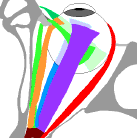
This collection of essays is related to the anatomy and movements of the eyes. It considers the anatomy of the eye and the extraocular muscles in the orbit and describes the anatomy in a quantitative model that allows one to make deductions about the movements of the eye produced by contractions of each extraocular muscle, when the eye is in any position within its normal range.
| Introduction to Quaternions [ Word | PDF ] These essays are very fundamental. They address the basic mathematics that lies at the foundations of the biomechanical analysis presented in the other essays. The other essays assume that the reader is familiar with the basic ideas described in this section. |
|
| Analysis of a Universal Joint: Movements and Muscles of the Eye [ Word | PDF ] This essay introduces some of the anatomy of the eyeball, the extraocular muscles, and the orbit which is pertinent to the mathematical studies, then develops a mathematical description that may be manipulated to answer questions about the manner in which the extraocular muscles cause the eye to move. It is based on the traditional anatomical description of the extraocular muscles, which differs from the actual anatomy (see next essay). It is found that the sets of eye muscle lengths for stationary gaze lie on a single surface. That surface is computed. |
|
| Geometrical Anatomy of the Eye and Eye Movements: A Model with Restricted Extraocular Muscles [ Word | PDF ] In this essay the model developed and studied in the first essay is modified to take into consideration that the extraocular muscles do not move freely, as stated in the traditional model, but they are constrained by fascial slings in the periorbital tissues that effectively move the muscle origins for the recti to the vicinity of the equator of the eyeball. The model in the first essay is recalculated with this further constraint and the eye movements as a result of contractions of the extraocular muscle re-assessed |
|
| Spin Neutrality and Eye Movement Trajectories [ Word | PDF ] The analysis for this essay grew out of the material considered in the first two essays, but takes the analysis in a different direction. The essay considers the trajectories that will carry the eye from one gaze to another while insuring that the eye will be optimally oriented for seeing when it arrives at the end of its trajectory. It finds that the trajectory that achieves this task is a trajectory that passes through the gaze positions for stationary gaze. Consequently, the set of eye muscle lengths can vary during the movement in such a way that they always lie in the surface computed in the first essay. Such trajectories are not the most direct path between the two gazes. |
